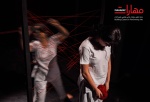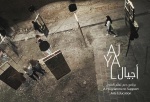
Palestine as a “Profession”: Syria also? By Fatin Farhat, Palestine
Sep 2017
As part of Ettijahat- Independent Culture’s Programme, the Cultural Priorities in Syria, we are currently compiling a series of articles addressing the challenges facing Syrian cultural work. These articles have been written by Syrian and non-Syrian experts alike, as well as various cultural actors.
The first topic the articles explore is the relationship between artistic content, public events, and message concepts.
Today, who determines the nature of the artistic standards governing the Syrian creative process?
What are the new red lines and censorship requirements governing art production inside and outside Syria?
How can we review and learn lessons from comparable international cases?
‘Palestine as a “Profession”: Syria also?’ By Fatin Farhat, Expert at UNESCO, PhD researcher at University of Hildesheim, Germany, tries to highlight some possible answers.
When my friend Abudllah Al Kafri invited me to share my personal and professional experience as a Palestinian cultural activist and researcher within the framework of Ettijahat-Independent Culture’s Syrian Cultural Priorities Program, to possibly shed some light on the challenges facing the Syrian cultural sector at present, I instantly recalled his own intervention in Beirut back in December 2015 within the context of the annual meeting for the Arab Cultural Policy Group. Back then, Abudllah and I sat on the same panel that addressed the problematic topic of “Cultural Policies under Unusual Circumstances”. Abudllah’s insight on Syrian artists and the challenges that face the cultural sector inside Syria and countries of refuge, was tragic and echoed to a very large extent an experience I lived throughout my life in occupied Palestine, where the gravity of the violence, injustice and the pain can be paralyzing. That night, I went to bed, with the hope that Syria and the Syrians will be spared. Unfortunately, the situation only significantly deteriorated since then.
Over the past years, I have borne witness to the dispersal of my Syrian artist friends from Syria, to Beirut and then everywhere in the world. I was also lucky enough to meet one artist who has chosen to stay in Damascus. I have been engaged in intimate long conversations with my Syrian artists and manager friends over drinks in Beirut, London, Berlin, Tunis, and Cairo and through social media of course in conferences and discussion sessions. I often found myself silent and desperate. I could only offer messages of support and frequent embraces! The incredible political, social and cultural changes that Syria has gone through in an extremely short period of time, are hard to comprehend, analyze and reflect on and any attempts of making sense of the situation will be incomplete.
Yet and whereas the core of the conflict in Syria is different than in Palestine, many symptoms that echo and resemble the conflict in Palestine can be traced (with a lot of humility and caution in respect of each experience), in particular with relation to cultural identification and creativity.
A few weeks ago, Palestinian researcher Dr. Issam Nassar published a reflective article titled “Palestine as a Profession: Researchers, the Israelis and the Looted Cultural Heritage”.[1] The article addresses the Israeli looting as well as the self-inflicted Palestinian loss of a significant volume of Palestine’s cultural heritage since early 20th century. It also traces some Palestinian, foreign and even Israel attempts to salvage /reconstruct this heritage through numerous significant research and arts projects. Sarcastically and very truly really, Issam proposes the term “Palestine as a Profession” in his insightful piece. A few days later, Palestinian artist Shuruq Harb puts out via Ocula: “Don’t Confuse me for the Monkey on Bankey’s Walled off Hotel”. The piece addresses the controversial Bethlehem based hotel with the worst view in the world) view of the apartheid wall) and raises significant uneasy questions on the instrumentalization art for the benefit of the Palestinian. From Nasser’s article, for the purpose of this piece, I wish only to borrow the term “Palestine as a Profession”, a term that correspondingly captures the essence of Harb’s writing.
“Palestine as a Profession” has become over the last few decades a problematic concept strictly and rigidly framed to represent an image/version of what a “Palestinian” is expected to be in relation to diverse internal and external perceptions. Palestinian artists in the homeland and the exile have always been on the frontline of this predicament. Palestinian artists and writers have felt obligated to continuously persevere Palestinian cultural heritage eradicated by the military occupation and to use the Israeli occupation as a direct metaphor in their art work (literature, cinema, visual arts, and music). Such expectations of an image of an artist were self-inflicted by Palestinians but also externally employed. The impact has been so intense that many artists and researchers investigated the potential destiny of “Palestinian art” without the Israeli occupation. The political narrative promoted by the Palestine revolution translated every aspect of life into political themes. Visual artist Majd Abelhamid articulately captures this actuality: “Palestinian art in general is preoccupied with the fact that there is an occupation. Art's function was to tell Palestinians that we exist,” he says. Moreover, Palestinian artists seem to have been corned for decade in a comfort zone of being a “Professional Palestinians” with a mission and duty when even artistic quality could sometimes be overlooked and compromised for the greater good, a status that also brought a diverse spectrum of funding and collaboration activities. The fascination has often been with Palestine rather than with the art work itself.
The situation started to slowly alter post the Oslo agreement in 1994 in Palestine. Feeling more at liberty from the “direct parameters of occupation" “visual artists, theater directors, writers, filmmakers, musicians, choreographers and photographers have produced captivating works dealing with trauma, violence, occupation, colonial heritage but also with poverty, sexuality and desire, women’s social status, marginalization, emigration, refugees, authority, patriarchy and failed governance”. With the peace process (albeit of its numerous shortcomings) Palestinian artists were relatively liberated, from the direct political compulsion, and started addressing the Palestinian issue through a globalized and more humanistic perspective and also to address other political and social anxieties. On many occasions artists (even the most politically committed) have expressed relief to this new freedom and slowly Palestinian art is placing itself by the virtue of its merit in the regional and international art scene.
Ironically this dispersal of the Palestinian population since 1948, parallels to a very large extent the dispersal of Syrians in neighboring countries and around the world. A dispersal of frightening and unprecedented numbers that occurred in a short period of time creating an unmatched plight and placing Syria in the core of regional and international media, humanitarian, and political, a role that once was occupied by Palestine. This poses now major new challenges and yet opportunities for the Syria cultural movement (principally aboard) and its attempt to contribute to the future reconstruction of Syria and the image of Syria, notwithstanding the immense pain of the process. The exodus of Syrian artists is in particular worth examination. Unlike the situation in Palestine, Syria possesses some of the most important artistic training establishments in the Arab world in specialized higher education in the arts. The majority of the artists and art practitioners dispersed enjoy extraordinarily high technical and artistic skills. The flight of Syrian artists in different Arab, European, Canadian and other cities is an added value to the cities and should be treated as such. Syrian artists don’t solely have the capacity to represent the plight of the people (in the homeland and outside) but also possess the artistic and intellectual capacities that enable them to escape solely becoming “professional Syrians” or to be solely mirrored within the context of political parameters of the struggle in Syria. Yet, with their own personal moral responsibilities towards Syria and with the availability of diverse funding schemes and opportunities now offered to Syrian artists specifically, artists will be pressured to produce works that mirror the political context. It’s always a hot and catchy issue and the balance is not always easily struck, and perhaps should not be struck now, perhaps it’s still premature to ask for such a balance to exist. Perhaps this period should be viewed as a period of survival and reflection to set the ground for the emergence of a more structured process. It might not be very obvious now but the artistic movement that is being formed outside Syrian is sturdily creating a strong independent artistic scene that is strongly embodied in the spirit of a civic movement reinforced by regional and international partnerships that could be potentially instrumental in any future reconciliation process in Syria or more specifically in any future possible reconstruction of cultural policy in the country. In this context, it is only appropriate to share the experience of the influx of exiled Palestinian artists who have returned to Palestine post 1994. Having lived in various cosmopolitan Arab settings such as Beirut, Damascus, Cairo, Tunis, and of course elsewhere in the world, this sector of Palestinian society was privileged to be exposed to a unique medley of various cultures and regional and international artistic and cultural experiences.
What matters now is for the debate to continue. Syrian artists and practitioners will remain at the risk of becoming “professional Syrians” as long as the conflict continues and beyond. Self awareness of this risk is of absolute necessity and so is the self confidence in the added value proposed by Syrian artists and art practitioners to the artistic scene in the region and within the communities of their refuge, an awareness that should enable them better negotiate the terms and conditions of their work. Attempts to embark on an inner Syrian dialogue to prioritize in accordance to artists’ general needs is imperative in anticipation for the future to come. Nevertheless, self examination of the individual needs of artists and practitioners is also necessary and it is essential that they are exercised in an open, non judgmental and empathetic environment. An environment that respects the individual choices of artists and values experiences. Of course art is a representation of society and is not detached from the common concerns of the community, yet it’s also a personal choice and a process of individual catharsis.
[1] Nassar, Issam. “Palestine as a Profession: Researchers, Israelis, Looting of Palestinian Cultural Heritage”. 12-6-2017. http://refugeesps.net/post/4580















